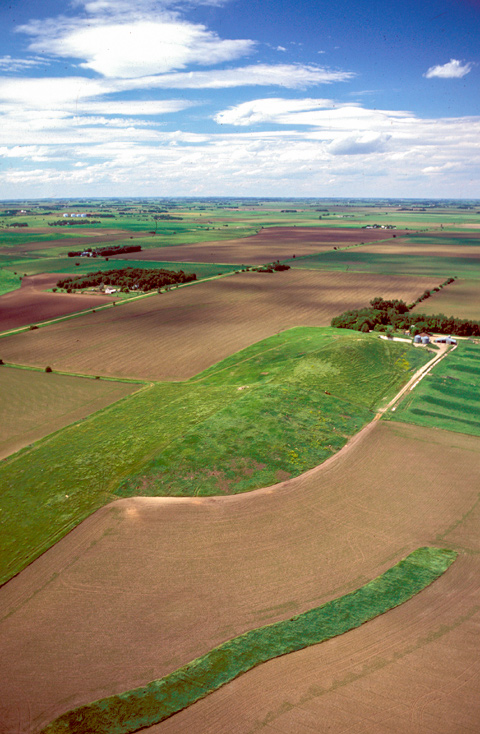On 25 August 1804, obedient to Jefferson’s instruction to observe Indians traditions, monuments and landmarks, Lewis and Clark went inland to visit a “conic form” rising from the plain.[1]Jackson, Letters, 1:62. Local Sioux, Omaha, and Oto Indians related its fascinating legends with enough passion and color to beguile the explorers into making time to visit it, despite the oppressive late-August heat, and gave them enough details to lead them directly to its location, roughly nine miles north and twenty degrees west from the mouth of the “White Stone” (Vermillion) River.[2]The water course they followed part of the way was labeled the Kenville River on John Evans‘s manuscript map (Moulton, Atlas, map 7), a copy of which was in the captains’ hands, but Clark … Continue reading The storytellers called it the “Mountain of little people or Spirits,” knee-high, big-headed demons who repelled mortals with “murceyless fury.”
Unmolested by the “unusial Spirits,” the party, consisting of the two captains, ten men of the Corps including Clark’s servant and slave, York, and Lewis’s dog Seaman, hiked to the foot of the mound and climbed to its highest point—that “conic form.” They viewed the surrounding plains, and saw herds of buffalo grazing among distant hills. They made note of the cloud of insects in the mound’s lee and the birds that feasted on them. Clark described the shape and dimensions of the mound, as well as the character of the surrounding landscape, in exceptional detail.[3]Three of the four journal entries for this date are under Clark’s name. The fourth, a mere 83 words long, is Lewis’s, but it contains nothing substantive concerning the day’s ramble … Continue reading
An Evolving Story
Spirit Mound, 2011
View southeast
© 2011 by Kristopher K. Townsend. Permission to use granted under the Creative Commons Attribution-Share Alike 4.0 International license.
Within recent years—thanks to the pride and energy of today’s locals, both Indian and otherwise—the farm and its sheltering trees are now gone, and the mound’s green mantle blooms each May with native prairie grasses and flowers.
The captains and their ten companions enjoyed the delightful prospect, with herds of buffalo grazing among the distant hills. To escape that “murceyless” wind, insects clouded in the mound’s lee, where gentle brown martins flocked to feast on them. The story of the slow evolution and shape-shifting of such landforms beneath life-loaded inland seas, ice-long glaciers, and inchmeal abrasions by wind and rain was not yet within the purview of Clark’s generation’s understanding.
Nearly 200 years later, it is certain that this “Conic form,” its crown now a scant one hundred feet above the “emence Plain,” began as a pile of seashells some eighty million years ago, then was draped in glacial drift, trodden firm by bovine hooves, only to be restored as tallgrass prairie. The vivid Indian legend survives, with the short story of Lewis and Clark’s visit hanging on it like a matching handbag.
For more, see on this site Spirit Mound.
From Discovering Lewis & Clark from the Air
Photography by Jim Wark
Text by Joseph Mussulman
Reproduced by permission of Mountain Press
Spirit Mound is a High Potential Historic Site along the Lewis and Clark National Historic Trail managed by the U.S. National Park Service. The site is open to the public and maintained by South Dakota Game, Fish and Parks.—ed.
Notes
| ↑1 | Jackson, Letters, 1:62. |
|---|---|
| ↑2 | The water course they followed part of the way was labeled the Kenville River on John Evans‘s manuscript map (Moulton, Atlas, map 7), a copy of which was in the captains’ hands, but Clark renamed it “the river of white Stone,” perhaps with the prompting of local Indian informants, although the proper term would be white clay, which was used for body painting. Various EuroAmericans variously called it White Earth, Smoky Earth, and Red River or Redstone—the last one imposed by Clark when the party passed it on 3 September 1806, en route home. Perhaps he had learned that the Dakota Sioux called it Wa-se-sa (pronounced Washisha) Wa-kpa, meaning “red stone river,” which some anonymous French traveler had translated as Vermillion. The red stone is ocher, a hydrated iron oxide once commonly used by Native peoples as a decorative coloring, including body paint. They also obtained white earth paint from the valley, which might explain Clark’s first-mentioned name (Journals, 8:507, note 10). |
| ↑3 | Three of the four journal entries for this date are under Clark’s name. The fourth, a mere 83 words long, is Lewis’s, but it contains nothing substantive concerning the day’s ramble beyond the statements that on their way back to camp they saw the first bats since the expedition began, and the colors of “a bird of heron kind” which they failed to shoot, so he had no specimen to describe. However, Clark’s long description of the mound and its shape, dimensions, makeup, habitat, and viewshed, clearly originated with Lewis, judging from its diction, style, and orthography. It was either dictated to Clark, or copied by him from a now-missing original. |
Experience the Lewis and Clark Trail
The Lewis and Clark Trail Experience—our sister site at lewisandclark.travel—connects the world to people and places on the Lewis and Clark Trail.
Discover More
- The Lewis and Clark Expedition: Day by Day by Gary E. Moulton (University of Nebraska Press, 2018). The story in prose, 14 May 1804–23 September 1806.
- The Lewis and Clark Journals: An American Epic of Discovery (abridged) by Gary E. Moulton (University of Nebraska Press, 2003). Selected journal excerpts, 14 May 1804–23 September 1806.
- The Lewis and Clark Journals. by Gary E. Moulton (University of Nebraska Press, 1983–2001). The complete story in 13 volumes.





